Understanding How ABA Enhances Perspective-Taking in Adolescents
In recent years, Applied Behavior Analysis (ABA) has gained recognition for its effectiveness in fostering social understanding and perspective-taking in teens, especially those with autism spectrum disorder (ASD). By employing evidence-based strategies, ABA helps adolescents develop critical social cognition skills, enabling them to navigate complex social environments confidently and authentically.
Core ABA Concepts for Teaching Perspective-Taking and Social Understanding
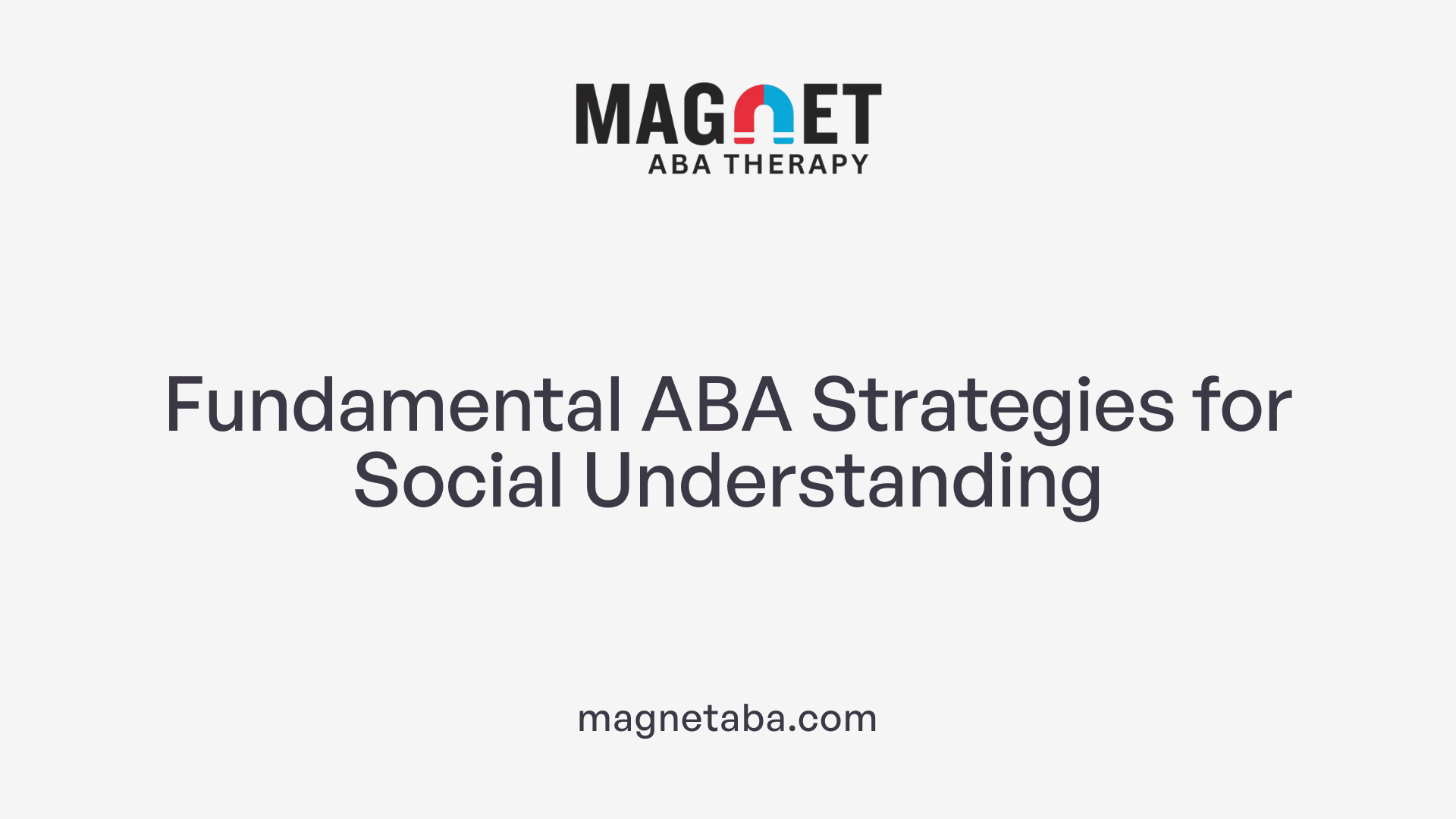 Applied Behavior Analysis (ABA) uses a variety of strategies to teach children with autism important social skills, including perspective-taking and understanding social cues.
Applied Behavior Analysis (ABA) uses a variety of strategies to teach children with autism important social skills, including perspective-taking and understanding social cues.
One fundamental element of ABA is task analysis. This involves breaking down complex social behaviors into smaller, manageable steps. For example, teaching a child to recognize different facial expressions or interpret body language can be decomposed into simple tasks, making learning more accessible.
Reinforcement strategies are central to ABA. When children demonstrate social skills correctly, they receive positive reinforcement—such as praise, tokens, or other rewards—which encourages continued practice and mastery.
Modeling and video modeling are effective techniques within ABA. Demonstrating appropriate social behaviors or showing videos of peers engaging in social interactions helps children observe and imitate desired responses. These methods make abstract social concepts more concrete.
Social stories and narratives are personalized stories that describe social situations and appropriate reactions, providing children with a clear understanding of social norms. Reading and creating stories about social scenarios help children relate to different perspectives and prepare for real-life interactions.
Behavioral Skills Training (BST) combines instruction, rehearsal, and feedback. This structured approach allows children to practice social skills actively, receive guidance, and improve through repetition.
Visual supports, such as checklists, visual schedules, and conversation flowcharts, assist children in understanding and applying social skills. These tools help organize social interactions and reduce anxiety about unpredictable social settings.
Active involvement of parents and caregivers is crucial. Consistent reinforcement and practice at home and in community settings ensure that skills learned in therapy generalize to everyday life. Collaborative efforts between therapists and families strengthen the child's social understanding.
In summary, ABA emphasizes a systematic, evidence-based approach to teach perspective-taking and social understanding. By breaking down skills, using reinforcement, modeling behaviors, employing visual supports, and involving families, ABA helps children with autism build meaningful social connections and navigate social environments confidently.
How ABA Techniques Support and Enhance Perspective-Taking in Teens
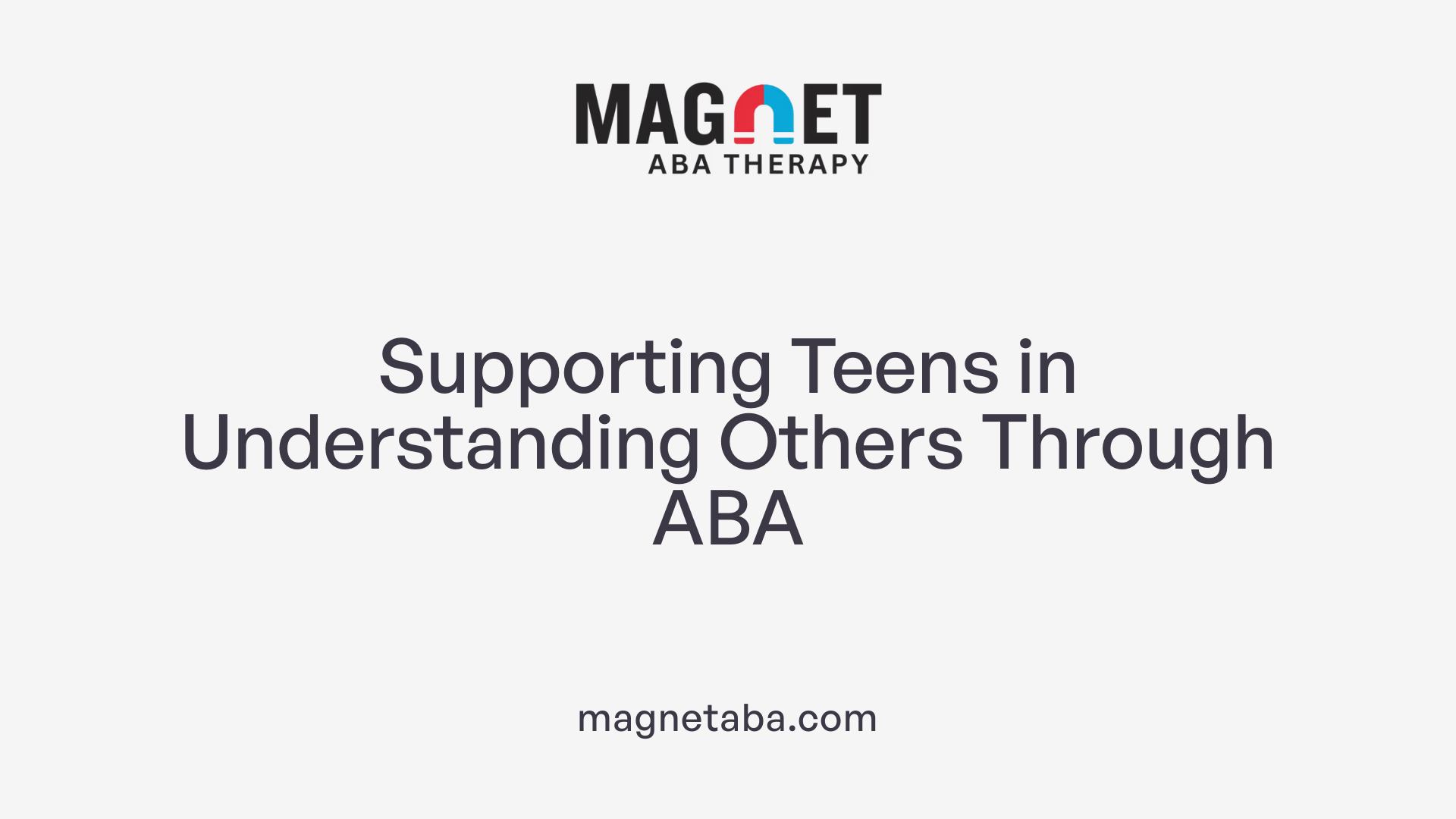
How do ABA techniques support and enhance perspective-taking skills in teens?
Applied Behavior Analysis (ABA) employs a variety of structured methods to help teens develop better understanding of others’ thoughts, feelings, and viewpoints. These techniques start with clear, direct instruction that breaks down social cues into manageable steps, making the learning process accessible and achievable.
Modeling is a fundamental strategy used in ABA. For example, clinicians or educators demonstrate appropriate social interactions and emotional recognition, providing teens with concrete examples of perspective-taking acts. Reinforcement, such as praise or tokens, is used to encourage successful attempts at understanding and responding to social cues.
Video modeling and social narratives are particularly effective tools in ABA for teens. Videos featuring relatable scenarios help them observe and interpret social behaviors naturally. Social stories, which are personalized stories about social situations, guide teens through expected behaviors and different perspectives, enabling them to mentally simulate various social outcomes.
Naturalistic teaching activities further support skill transfer by embedding learning in everyday settings. For instance, during routines like mealtime or group activities, teens are encouraged to recognize peers’ emotions and viewpoints, practicing in real-life contexts rather than artificial environments.
Importantly, ABA’s current approach aligns with principles of neurodiversity and autism acceptance. It emphasizes authentic self-expression and understanding over rote memorization of social scripts or masking behaviors. This fosters a genuine sense of self and encourages teens to voice their perceptions confidently.
By integrating these strategies, ABA not only enhances perspective-taking but also promotes self-advocacy. Teens learn to articulate their feelings and perspectives, understanding the impact of their actions on others. Overall, ABA techniques nurture meaningful social understanding rooted in respect for neurodiversity, empowering teens to connect authentically with others.
How ABA Therapy Effectively Improves Social Cognition in Teens
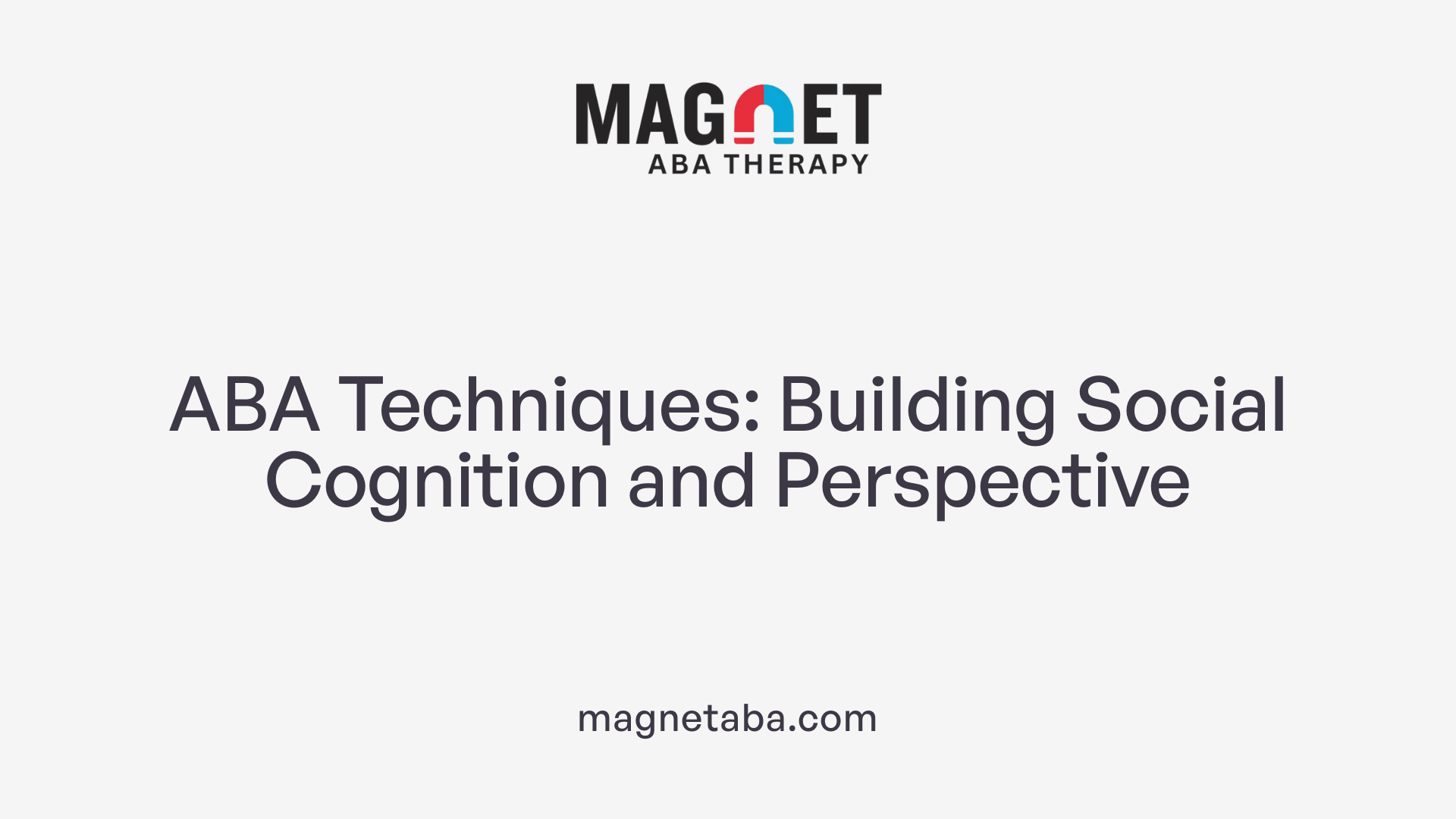 ABA therapy employs a variety of structured techniques to enhance social cognition and perspective-taking skills among teenagers with autism. Methods such as Discrete Trial Training (DTT), Natural Environment Training (NET), and Pivotal Response Treatment (PRT) form the backbone of these interventions.
ABA therapy employs a variety of structured techniques to enhance social cognition and perspective-taking skills among teenagers with autism. Methods such as Discrete Trial Training (DTT), Natural Environment Training (NET), and Pivotal Response Treatment (PRT) form the backbone of these interventions.
Discrete Trial Training involves breaking down complex social behaviors into smaller, manageable steps, allowing teens to learn social cues and appropriate responses systematically. This approach offers clear reinforcement for correct behaviors, encouraging mastery over each skill.
Natural Environment Training emphasizes practicing social skills within real-life contexts. By integrating learning into everyday situations, teens can better generalize their skills beyond the therapy setting, leading to more effective social interactions.
Pivotal Response Treatment focuses on pivotal areas such as motivation and self-management, which influence a broad range of social behaviors. Improving these areas leads to improvements in eye contact, conversational turn-taking, and understanding others' perspectives.
Visual supports—like social stories, cues, and emotion charts—are critical in helping teens recognize social cues and emotional expressions, providing concrete references that support understanding. Combining these with real-life practice opportunities enhances retention and transfer of skills.
An individualized, evidence-based approach is fundamental. Each teen’s unique strengths and challenges are assessed, and therapy plans are tailored accordingly. Reinforcement strategies, such as praise and tangible rewards, motivate progress in communication and emotional regulation.
Focusing on social skills development, ABA therapy promotes better peer interactions, increased empathy, and improved emotional understanding. These improvements foster independence in social situations and contribute to overall social confidence.
In summary, ABA techniques like DTT, NET, and PRT, supported by visual tools and real-world practice, help teens develop essential social cognition skills. This comprehensive, tailored approach prepares them for more meaningful social engagement and greater independence.
Strategies and Approaches in ABA for Developing Perspective-Taking
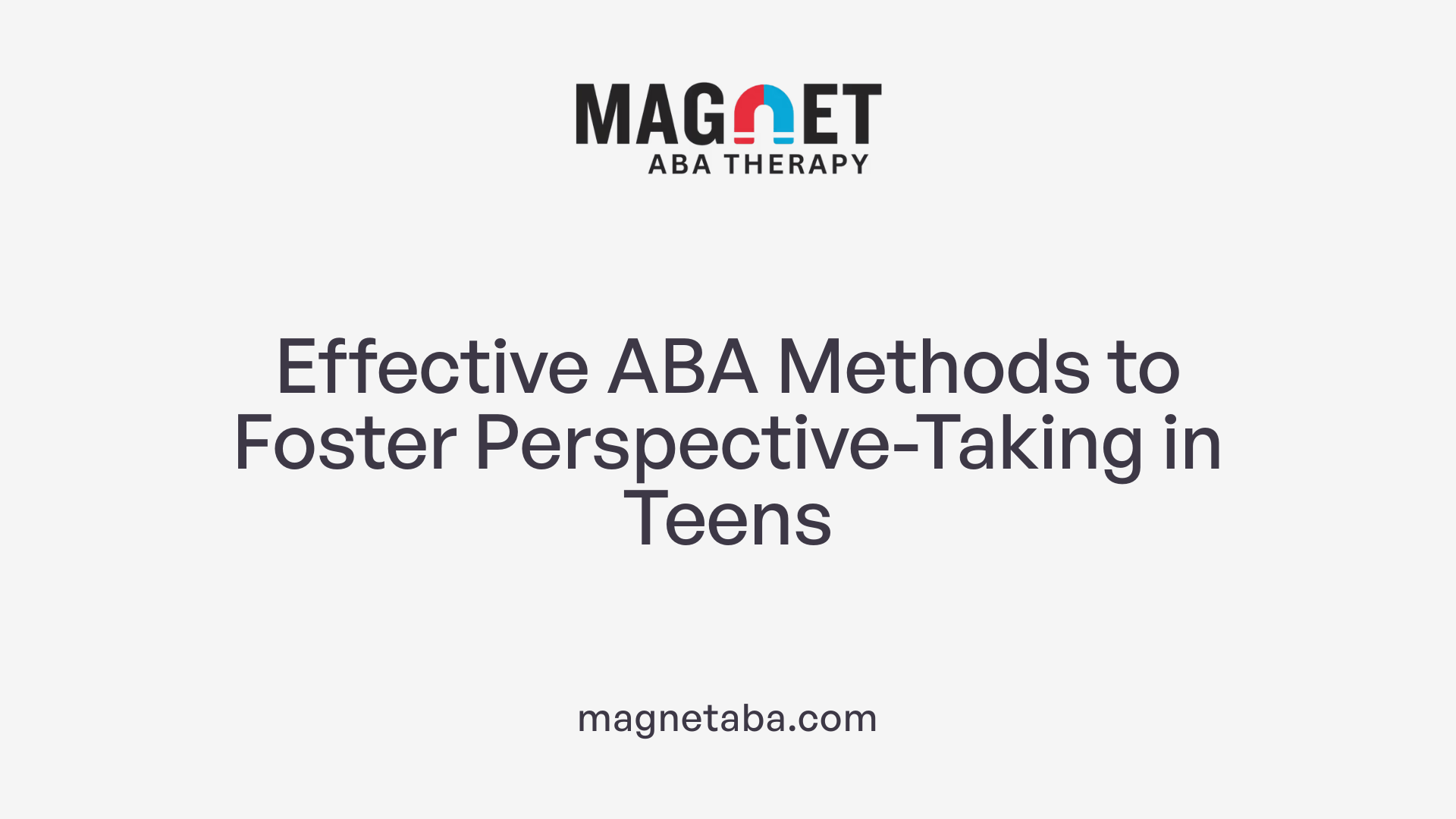
What strategies and methods are used in ABA to develop perspective-taking in adolescents?
In Applied Behavior Analysis (ABA), helping adolescents improve their perspective-taking skills involves a variety of structured, evidence-based techniques. These methods focus on teaching young individuals to understand and interpret others' thoughts, feelings, and intentions effectively.
One common approach includes role-playing, social stories, and the use of video exemplars. Role-playing allows adolescents to practice social situations in a safe environment, encouraging them to consider others' viewpoints. Social stories breakdown complex social interactions into manageable steps, making abstract concepts more concrete. Video exemplars, such as clips from programs like Daniel Tiger’s Neighborhood, demonstrate appropriate social behaviors and perspective-taking in real-life contexts.
Behavioral rehearsal and naturalistic teaching are also integral. These involve practicing social skills in everyday settings, ensuring learning is relevant and generalizes beyond therapy sessions. Multiple exemplar training is another effective strategy, where varying examples are used to teach a concept, helping learners apply skills flexibly across different situations.
Respectful and empowering practices are emphasized, focusing on fostering genuine understanding rather than rote scripting or masking. This involves tailoring interventions to individual preferences and needs, avoiding the development of stereotyped responses that do not reflect authentic perspectives.
Making abstract social concepts concrete is crucial. Techniques such as visual supports, social narratives, and storytelling help clarify feelings, beliefs, and social cues. Tools like digital apps (e.g., Touch and Learn – Emotions or Peppy Pals) further make learning accessible and engaging.
Overall, ABA methodologies for developing perspective-taking combine behavioral strategies, visual supports, and social narratives to support adolescents in understanding their peers better. This tailored, respectful approach boosts social cognition, fostering better relationships and social confidence.
| Strategy/Method | Description | Purpose |
|---|---|---|
| Role-playing | Practice social scenarios through simulated interactions | Develops perspective-taking and social skills |
| Social stories and narratives | Use stories to explain social situations and emotions | Breaks down social cues into understandable parts |
| Video exemplars | Demonstrate appropriate behaviors via video clips | Visual learning and modeling of perspectives |
| Behavioral rehearsal & naturalistic teaching | Practice skills in real-life or natural contexts | Generalization of social skills |
| Multiple exemplar training | Teach with varied examples to promote flexible understanding | Prevent rote responses, encourage authentic responses |
| Digital tools and visual supports | Use apps and visual aids to teach emotions and social cues | Make abstract ideas tangible and engaging |
For more information, searching
Educational Tools and Approaches for Developing Perspective-Taking in Teens
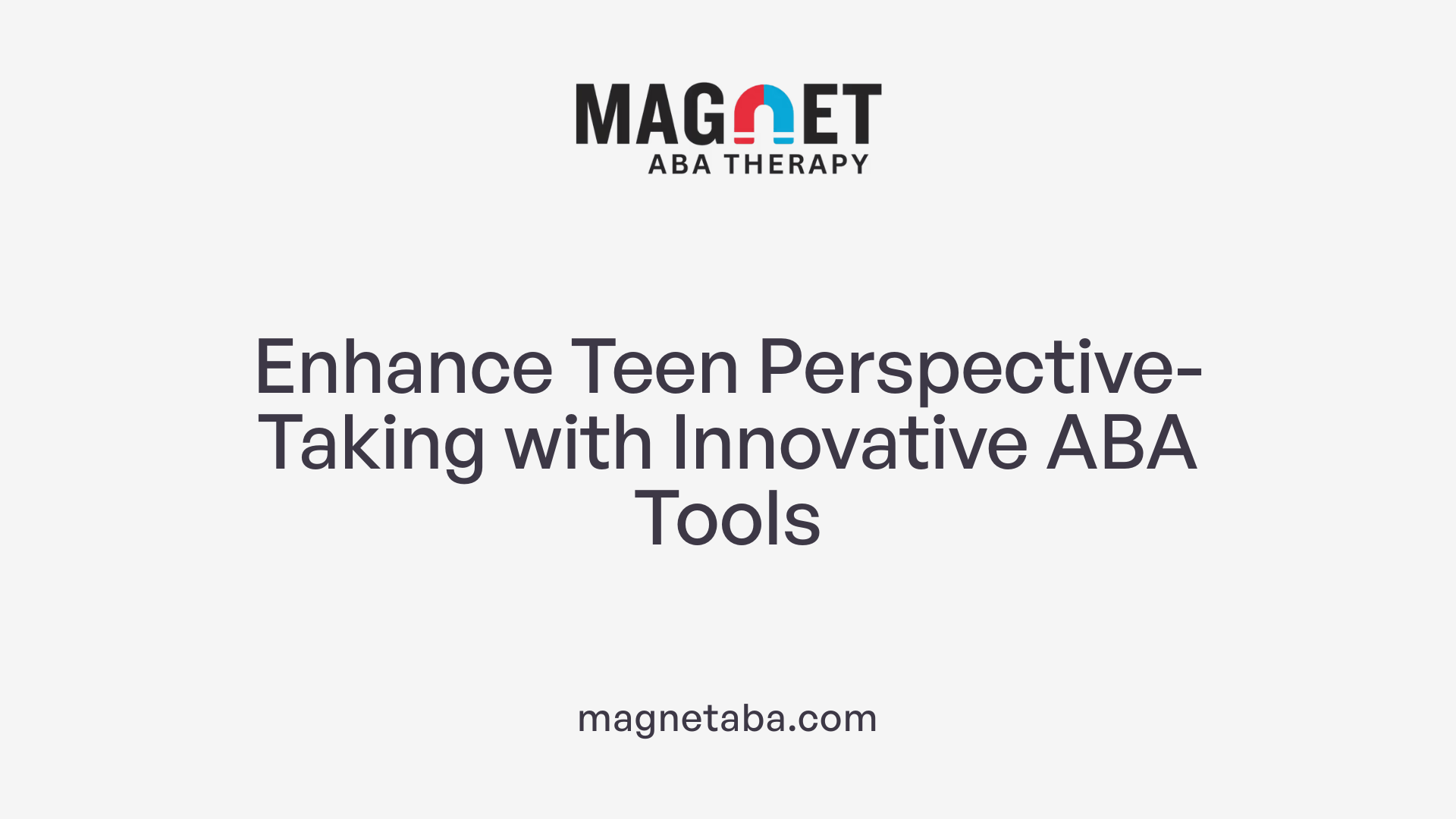
What educational tools and approaches within ABA are used for developing perspective-taking skills in teens?
In ABA-based education, a variety of tools and methods are used to help teens improve their ability to understand others’ viewpoints. These approaches make social concepts more concrete and accessible, especially for adolescents who are still developing these skills.
Social stories and social narratives are frequently employed. These are short, visual or written tales that depict social situations from different perspectives, helping teens understand the thoughts and feelings of others. By reading and discussing these stories, teens learn to interpret social cues and respond appropriately.
Video modeling is another powerful tool. It involves showing videos of peers or actors demonstrating perspective-taking behaviors. Seeing relatable and engaging examples can motivate teens to imitate desirable social responses in real life. Video-based group instruction further enhances learning through collective viewing and discussion.
Role-playing activities are essential for practicing perspective-taking in a safe setting. These simulated scenarios allow teens to step into different roles, encouraging them to think about what others might do or feel in various situations. Naturalistic teaching strategies, which involve real-world settings, provide opportunities for teens to apply these skills outside the classroom.
Specialized programs like the Visual Perspective Taking Program utilize physical models, images, and targeted questions. These help teens recognize that others might see or perceive the same scene differently, based on their physical position or experiences. This foundational understanding is crucial for advancing social cognition.
Across all these approaches, reinforcement strategies play a vital role. Positive reinforcement, such as praise or tokens, motivates teens to engage with perspective-taking activities and reinforces their progress.
By combining social stories, video modeling, role-playing, and visual perspective programs with consistent reinforcement, ABA provides a comprehensive framework that supports teens in developing essential social understanding, ultimately leading to improved peer relationships and social confidence.
Research and Evidence Supporting ABA for Perspective-Taking in Teens
 Recent research underscores the positive impact of Applied Behavior Analysis (ABA) on developing perspective-taking skills among teenagers with autism and other neurodivergent conditions. Multiple studies and systematic reviews highlight that structured ABA interventions can significantly enhance social cognition, including Theory of Mind (ToM), which is essential for understanding others' thoughts and feelings.
Recent research underscores the positive impact of Applied Behavior Analysis (ABA) on developing perspective-taking skills among teenagers with autism and other neurodivergent conditions. Multiple studies and systematic reviews highlight that structured ABA interventions can significantly enhance social cognition, including Theory of Mind (ToM), which is essential for understanding others' thoughts and feelings.
Interventions such as behavioral skill training, video modeling, role-playing, and derived relation techniques are frequently utilized within ABA programs to teach adolescents how to recognize emotions, interpret social cues, and consider different viewpoints. For example, video modeling allows teens to observe and imitate appropriate social behaviors in a controlled setting, fostering better understanding of social interactions.
Improvements in social behaviors are often noted following these interventions, with many teens demonstrating increased empathy, better social interactions, and more accurate perspective-taking. However, despite encouraging results, maintaining these skills outside the structured therapy environment and generalizing them to everyday situations can be challenging.
The body of evidence supporting ABA’s effectiveness is growing but is constrained by methodological limitations, such as small sample sizes and lack of standardized measures across studies. Ethical considerations also call for rigorous, diverse, and carefully designed research to establish best practices.
In conclusion, the accumulated data suggest that ABA, when properly implemented and tailored to the individual, offers a promising avenue for enhancing perspective-taking in teenagers. Continued research will further clarify how to optimize these interventions for broader, long-lasting benefits.
Fostering Genuine Social Skills Through ABA
ABA's structured and individualized approach plays a pivotal role in supporting teens to develop authentic perspective-taking and social cognition skills. By combining various proven strategies and tools, ABA ensures that adolescents not only learn social cues and responses but also understand the deeper emotional and mental states of others. This comprehensive approach promotes more meaningful social interactions, greater empathy, and long-term social confidence, helping teens navigate their social worlds with greater ease and acceptance.
References
- Using Applied Behavior Analysis to Educate Students with ...
- Easy Ways to Teach Perspective Taking to an Autistic Child
- Helping Children with Autism Develop Perspective-Taking Skills
- Fun Activities and Tools for Building Perspective-Taking ...
- ABA Therapy for Enhancing Social Skills in Children
- How to Teach Social Skills Using ABA Principles
- Applied Behavior Analysis (ABA)












